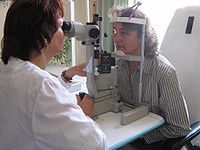
Photo from wikipedia
Background The increasing incidence of medical retinal diseases has created capacity issues across UK. In this study, we describe the implementation and outcomes of virtual medical retina clinics (VMRCs) at… Click to show full abstract
Background The increasing incidence of medical retinal diseases has created capacity issues across UK. In this study, we describe the implementation and outcomes of virtual medical retina clinics (VMRCs) at Moorfields Eye Hospital, South Division, London. It represents a promising solution to ensure that patients are seen and treated in a timely fashion Methods First attendances in the VMRC (September 2016–May 2017) were included. It was open to non-urgent external referrals and to existing patients in a face-to-face clinic (F2FC). All patients received visual acuity testing, dilated fundus photography and optical coherence tomography scans. Grading was performed by consultants, fellows and allied healthcare professionals. Outcomes of these virtual consultations and reasons for F2FC referrals were assessed. Results A total number of 1729 patients were included (1543 were internal and 186 external referrals). The majority were diagnosed with diabetic retinopathy (75.1% of internal and 46.8% of external referrals). Of the internal referrals, 14.6% were discharged, 54.5% continued in VMRC and 30.9% were brought to a F2FC. Of the external referrals, 45.5% were discharged, 37.1% continued in VMRC and 17.4% were brought to a F2FC. The main reason for F2FC referrals was image quality (34.7%), followed by detection of potentially treatable disease (20.2%). Conclusion VMRC can be implemented successfully using existing resources within a hospital eye service. It may also serve as a first-line rapid-access clinic for low-risk referrals. This would enable medical retinal services to cope with increasing demand and efficiently allocate resources to those who require treatment.
Journal Title: British Journal of Ophthalmology
Year Published: 2018
Link to full text (if available)
Share on Social Media: Sign Up to like & get
recommendations!